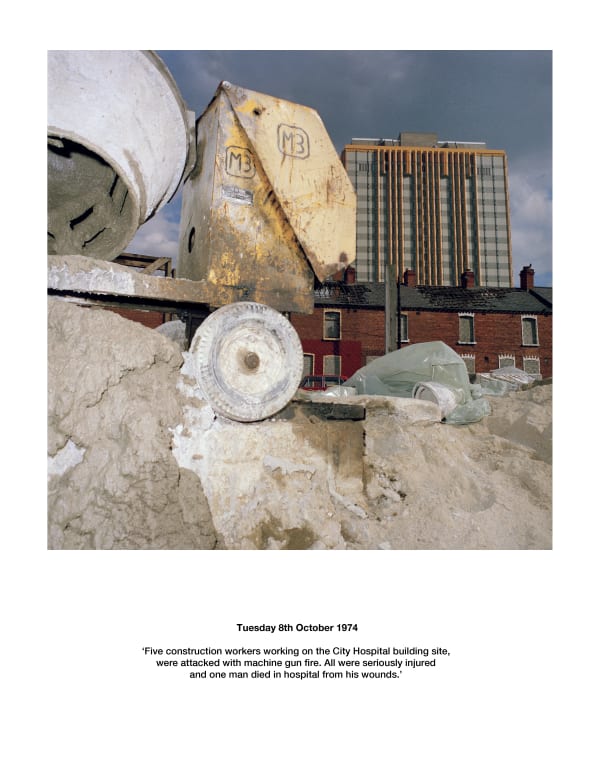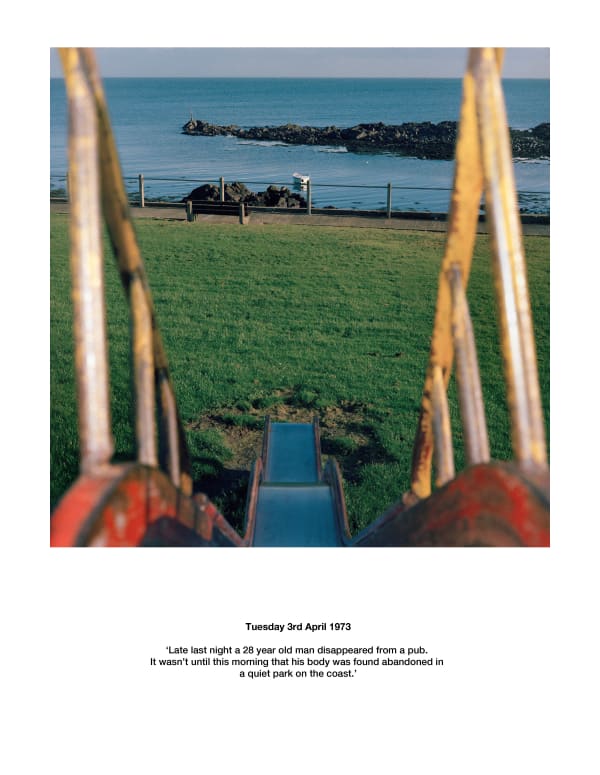The Hyman Collection of British Photography includes the complete set of Paul Seawright's most important body of work, Sectarian Murder. This powerful series of pictures has been exhibited in over twenty countries and did much to establish the artist's reputation. In Sectarian Murder Seawright revisited the sites of sectarian attacks during the 1970's close to where he grew up in Belfast. The texts are from newspaper reports at the time and document the murders of innocent civilians, killed for their perceived religion. Reference to Protestant or Catholic background was removed from the text.
The works power lies in the shocking gulf between the details of the demise of the victim and the banality of the locations, such as a children's playground and a well-known beauty spot. Through editing, Seawright notonly comments on the specifics of the Troubles but also transcends them to provide a more universal comment on cicvil war.
As Liam Kelly has written:
"Paul Seawright's photographic works are another example of the transformative power of text on image. During 1987/88, he made a series of... photographs based on visits to the scenes of various sectarian murders, or the locations where bodies were dumped in the early 1970s - an intense period of sectarian violence. He did not give the series a title, but reviewers have always referred to them as the Sectarian Murder series.
The time interval of some fifteen years between murderous and creative act was important to the artist, not only to ensure the religious anonymity of each victim, but also, in a sense, to indicate that the murdered were victims of being in the wrong place at the wrong time. Using an old diary from his youth, which noted significant political events among the fairly quotidian entries, Seawright spent protracted periods of time at these sites, considering the meanings associated with their location. In some cases, he re-enacted the route taken from the place from which a victim was snatched to the eventual spot of the murder or dumping of the body. Such reconstructions of reality built up tensions within the artist, as well as eliciting the lingering presence of gross transgressive acts from the location. Each scene was photographed in colour from the victim's viewpoint - close to the ground. The lighting of each scene was controlled, which paralleled the forensic photographer's cold, stark approach. These photographs, however, would remain merely interesting formalist studies if their accompanying text was not integral to their meanings. Seawright had researched original journalists' reports of these killings from local newspapers in Belfast, and selected snippets of text from such reports to work with and to discharge their related images of any easy reading. The text ties them down irrevocably to a place, a sub-culture and a value system of violence. In one work, a roadside inn is viewed, low down from the illuminated grassy edge of the road. A general feeling of tension is engendered by the angle of 'shooting', the absence of people, and the hiatus created between the nearside stationary car and the lorry about to pass the inn.
The blunt factual text tells of the killing of this misplaced victim. It also seems to indite the pictorial vehicles, as the location becomes perpetually marked and troubled. The essential difference between Paul Graham's photographs dealing with Northern Ireland, The Troubled Land (1987), and Paul Seawright's image and text photoworks, resides in the endorsement of lived experienced. As with TV coverage of such events, there is no reference to sectarian claims of justification or politicians' repudiations. The cold sparsity of the text, together with the concentrated absences in the photograph, unite to sustain a resounding moral condemnation of political cause and effect on both victim and violator." Liam Kelly, Thinking Long: Contemporary Art in the North of Ireland, Gandon Editions, 1996.

 Paul Seawright, City Hospital (from Sectarian Murder), 1988View more details
Paul Seawright, City Hospital (from Sectarian Murder), 1988View more details Paul Seawright, Cricket Ground (from Sectarian Murder), 1988View more details
Paul Seawright, Cricket Ground (from Sectarian Murder), 1988View more details Paul Seawright, Dandy Street (from Sectarian Murder), 1988View more details
Paul Seawright, Dandy Street (from Sectarian Murder), 1988View more details Paul Seawright, Dog (from Sectarian Murder), 1988View more details
Paul Seawright, Dog (from Sectarian Murder), 1988View more details Paul Seawright, Giants Rising (from Sectarian Murder), 1988View more details
Paul Seawright, Giants Rising (from Sectarian Murder), 1988View more details Paul Seawright, Glencairn (from Sectarian Murder), 1988View more details
Paul Seawright, Glencairn (from Sectarian Murder), 1988View more details Paul Seawright, Man in Bushes (from Sectarian Murder), 1988View more details
Paul Seawright, Man in Bushes (from Sectarian Murder), 1988View more details Paul Seawright, Roundabout (from Sectarian Murder), 1988View more details
Paul Seawright, Roundabout (from Sectarian Murder), 1988View more details Paul Seawright, Slide (from Sectarian Murder), 1988View more details
Paul Seawright, Slide (from Sectarian Murder), 1988View more details Paul Seawright, SM Chip Shop (from Sectarian Murder), 1988View more details
Paul Seawright, SM Chip Shop (from Sectarian Murder), 1988View more details Paul Seawright, You Can Help (from Sectarian Murder), 1988View more details
Paul Seawright, You Can Help (from Sectarian Murder), 1988View more details











